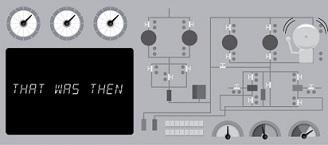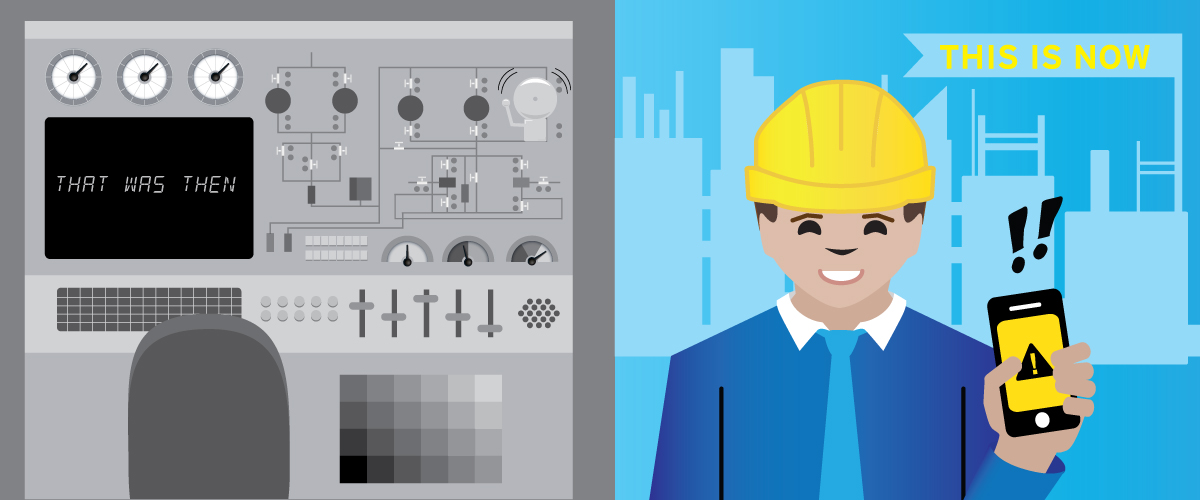We recently explored the current trends and market forces that will guide future SCADA innovations. As alarm notification providers thinking about the future, it’s sometimes important to reflect on the past. WIN-911 alarm notification systems help plant operators navigate challenges that get in the way of communication, safety, and productivity. How we meet those needs is ever-evolving.
The current move to adapt alarm notification interfaces for mobile phone and tablet interfaces reflects the growing pervasiveness of that technology. It’s the future. But carrying your work around with you in your back pocket isn’t anything particularly modern or new. Today it’s smartphones; in the early days of SCADA systems, it was pagers.
Early Remote Providers Were “All Talk”
The SCADA industry came into its own, starting in the 80’s with the release of Microsoft Windows. At this time you could say art imitated life: early graphic interfaces for SCADA systems featured digital representations of the dials, switches, and lights of analog control panels in use at the time. While a quaint, and even humorous, image, it personifies the at-times-awkward relationship between emerging digital and contemporary analog technologies. SCADA systems were confined to imitating mechanical systems.
This worked well when control rooms were all that was necessary, but soon operators wanted remote notification systems. Early remote alarm providers in the 80’s used pagers and auto-dialers to send out remote alarms through phone lines. The technology was reliable and economical, but there were limits. These systems couldn’t escalate alarms, or allow people on the receiving end of a call or page acknowledge the alarm. They couldn’t do more than simply duplicate an alarm. You could say trying to ascertain the status of an unfolding situation was a literal a game of telephone.
Developers Refused to Dial Down Their Technology
To overcome these limitations, SCADA software developers started to engineer their own in-house alarm software. Fundamentally, on the back end, the SCADA was there to record alarms. They just had no means to deliver that message remotely and did not like having to pass that business over to a third party. First, they tried software that worked with phones and pagers. But, working with telephone systems outside of the major remote auto-dialer firms was fraught. Phone systems were complex, and required specialized training to implement and manage. When the software worked consistently well, the hardware sometimes didn’t. Phone lines would go down, modems would malfunction. Operators would be, understandably, unhappy, and associate the service failures with the software.
The early adopters of SCADA systems, who remain stalwart in their use today — aerospace, automotive, water and city utilities — have high stakes tied into the reliability of those systems. It was imperative that a solution could be found that safeguarded their operations from unreliable technology.
This is where WIN-911 came in.
Cooperation Led to Innovation
In the early 90’s, we thought “instead of duplicating alarms, we should build a platform that receives the alarms from the SCADA and sends them out”. A focus on reception over duplication allowed us to focus more on getting the message out, working on flexible escalation regarding how the alarm was dispatched, to who and when.
For the software to be viable, we had to build drivers from scratch for each of the major SCADA software platforms, now known as “direct connectors.” To do that the SCADA companies had to share their code base with us. Letting us “under the hood” of their software allowed SCADA companies to abandon their own efforts to resolve the unreliability. In turn, we were able to build reliable tools that allowed our SCADA partners to effectively communicate unfolding events to the people in charge of overseeing them.
This is how WIN-911 became the standard go-to remote alarm notification product for SCADA systems, and why we continue to be on the forefront of innovative development. As SCADA systems evolve and expand, WIN-911 will continue to keep pace with technological trends.
The best traditions enable you to approach modern problems. Helping our partners adapt to new technology, and working around the limitations of current technology, remains integral to the strategy and values of WIN-911.
It’s who we were, who we are, and who we endeavor to be.


